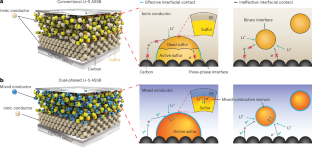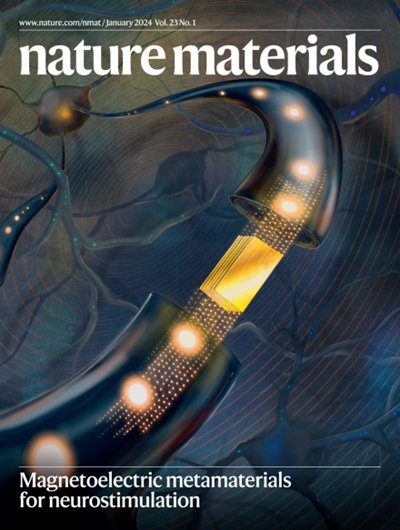Overcoming the conversion reaction limitation at three-phase interfaces using mixed conductors towards energy-dense solid-state Li–S batteries
IF 37.2
1区 材料科学
Q1 CHEMISTRY, PHYSICAL
引用次数: 0
Abstract
Lithium–sulfur (Li–S) all-solid-state batteries (ASSBs) hold great promise for next-generation safe, durable and energy-dense battery technology. However, solid-state sulfur conversion reactions are kinetically sluggish and primarily constrained to the restricted three-phase boundary area of sulfur, carbon and solid electrolytes, making it challenging to achieve high sulfur utilization. Here we develop and implement mixed ionic–electronic conductors (MIECs) in sulfur cathodes to replace conventional solid electrolytes and invoke conversion reactions at sulfur–MIEC interfaces in addition to traditional three-phase boundaries. Microscopic and tomographic analyses reveal the emergence of mixed-conducting domains embedded in sulfur at sulfur–MIEC boundaries, helping promote the thorough conversion of active sulfur into Li2S. Consequently, substantially improved active sulfur ratios (up to 87.3%) and conversion degrees (>94%) are achieved in Li–S ASSBs with high discharge capacity (>1,450 mAh g–1) and long cycle life (>1,000 cycles). The strategy is also applied to enhance the active material utilization of other conversion cathodes. Low-cost conversion cathodes are promising for future all-solid-state battery technology, but their poor electronic and ionic conductivity restrict reactions to three-phase boundaries. By using mixed ionic–electronic conductors, conversion reactions can be initiated at two-phase boundaries, resulting in enhanced discharge capacity and lifespan.


利用混合导体克服三相界面转换反应的限制,实现高能量固态锂-s电池
锂硫(Li-S)全固态电池(ASSBs)有望成为下一代安全、耐用和高能量的电池技术。然而,固态硫转化反应在动力学上比较迟缓,而且主要受限于硫、碳和固态电解质的三相边界区域,因此实现硫的高利用率具有挑战性。在此,我们在硫阴极中开发并实施了混合离子电子导体(MIEC),以取代传统的固体电解质,并在硫-MIEC界面(除传统的三相边界外)引发转化反应。显微镜和断层扫描分析表明,在硫-MIEC 界面出现了嵌入硫中的混合导电域,有助于促进活性硫彻底转化为 Li2S。因此,在具有高放电容量(1,450 mAh g-1)和长循环寿命(1,000 次)的 Li-S ASSB 中,活性硫比率(高达 87.3%)和转化率(94%)都得到了大幅提高。该策略还可用于提高其他转换阴极的活性材料利用率。
本文章由计算机程序翻译,如有差异,请以英文原文为准。
求助全文
约1分钟内获得全文
求助全文
来源期刊

Nature Materials
工程技术-材料科学:综合
CiteScore
62.20
自引率
0.70%
发文量
221
审稿时长
3.2 months
期刊介绍:
Nature Materials is a monthly multi-disciplinary journal aimed at bringing together cutting-edge research across the entire spectrum of materials science and engineering. It covers all applied and fundamental aspects of the synthesis/processing, structure/composition, properties, and performance of materials. The journal recognizes that materials research has an increasing impact on classical disciplines such as physics, chemistry, and biology.
Additionally, Nature Materials provides a forum for the development of a common identity among materials scientists and encourages interdisciplinary collaboration. It takes an integrated and balanced approach to all areas of materials research, fostering the exchange of ideas between scientists involved in different disciplines.
Nature Materials is an invaluable resource for scientists in academia and industry who are active in discovering and developing materials and materials-related concepts. It offers engaging and informative papers of exceptional significance and quality, with the aim of influencing the development of society in the future.
 求助内容:
求助内容: 应助结果提醒方式:
应助结果提醒方式:


